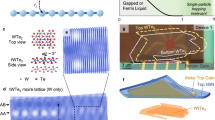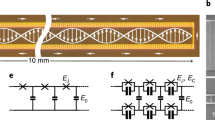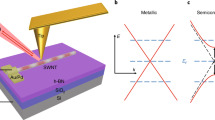Abstract
A Luttinger liquid is an interacting one-dimensional electronic system, quite distinct from the ‘conventional’ Fermi liquids formed by interacting electrons in two and three dimensions1. Some of the most striking properties of Luttinger liquids are revealed in the process of electron tunnelling. For example, as a function of the applied bias voltage or temperature, the tunnelling current exhibits a non-trivial power-law suppression2,3. (There is no such suppression in a conventional Fermi liquid.) Here, using a carbon nanotube connected to resistive leads, we create a system that emulates tunnelling in a Luttinger liquid, by controlling the interaction of the tunnelling electron with its environment. We further replace a single tunnelling barrier with a double-barrier, resonant-level structure and investigate resonant tunnelling between Luttinger liquids. At low temperatures, we observe perfect transparency of the resonant level embedded in the interacting environment, and the width of the resonance tends to zero. We argue that this behaviour results from many-body physics of interacting electrons, and signals the presence of a quantum phase transition4,5. Given that many parameters, including the interaction strength, can be precisely controlled in our samples, this is an attractive model system for studying quantum critical phenomena in general, with wide-reaching implications for understanding quantum phase transitions in more complex systems, such as cold atoms6 and strongly correlated bulk materials7.
This is a preview of subscription content, access via your institution
Access options
Subscribe to this journal
Receive 51 print issues and online access
$199.00 per year
only $3.90 per issue
Buy this article
- Purchase on Springer Link
- Instant access to full article PDF
Prices may be subject to local taxes which are calculated during checkout




Similar content being viewed by others
References
Giamarchi, T. Quantum Physics in One Dimension (Oxford Univ. Press, 2004)
Chang, A. Chiral Luttinger liquids at the fractional quantum Hall edge. Rev. Mod. Phys. 75, 1449–1505 (2003)
Deshpande, V. V., Bockrath, M. W., Glazman, L. I. & Yacoby, A. Electron liquids and solids in one dimension. Nature 464, 209–216 (2010)
Sachdev, S. Quantum Phase Transitions 2nd edn (Cambridge Univ. Press, 2011)
Vojta, M. Impurity quantum phase transitions. Phil. Mag. 86, 1807–1846 (2006)
Bloch, I. Ultracold quantum gases in optical lattices. Nature Phys. 1, 23–30 (2005)
Si, Q. & Steglich, F. Heavy fermions and quantum phase transitions. Science 329, 1161–1166 (2010)
Kane, C. L. & Fisher, M. P. A. Transmission through barriers and resonant tunnelling in an interacting one-dimensional electron gas. Phys. Rev. B 46, 15233–15262 (1992)
Eggert, S. & Affleck, I. Magnetic impurities in half-integer-spin Heisenberg antiferromagnetic chains. Phys. Rev. B 46, 10866–10883 (1992)
Nazarov & Glazman, L. I. Resonant tunnelling of interacting electrons in a one-dimensional wire. Phys. Rev. Lett. 91, 126804 (2003)
Polyakov, D. G. & Gornyi, I. V. Transport of interacting electrons through a double barrier in quantum wires. Phys. Rev. B 68, 035421 (2003)
Komnik, A. & Gogolin, A. O. Resonant tunnelling between Luttinger liquids: a solvable case. Phys. Rev. Lett. 90, 246403 (2003)
Milliken, F., Umbach, C. & Webb, R. Indications of a Luttinger liquid in the fractional quantum Hall regime. Solid State Commun. 97, 309–313 (1996)
Maasilta, I. & Goldman, V. Line shape of resonant tunnelling between fractional quantum Hall edges. Phys. Rev. B 55, 4081–4084 (1997)
Kastner, M. A. Artificial atoms. Phys. Today 46, 24–31 (1993)
Kouwenhoven, L. P. et al. in Mesoscopic Electron Transport (eds Sohn, L. L., Kouwenhoven, L. P. & Schön, G. ) 105–214 (Kluwer, 1997)
Leggett, A. J. et al. Dynamics of the dissipative two-state system. Rev. Mod. Phys. 59, 1–85 (1987)
Ingold, G.-L. & Nazarov, Y. V. in Single Charge Tunnelling: Coulomb Blockade Phenomena in Nanostructures (eds Grabert, H. & Devoret, M. H. ) 21–107 (Plenum Press, 1992)
Flensberg, K., Girvin, S., Jonson, M., Penn, D. R. & Stiles, M. D. Quantum mechanics of the electromagnetic environment in the single-junction Coulomb blockade. Physica Scripta T42, 189–206 (1992). ≈
Joyez, P., Esteve, D. & Devoret, M. H. How is the Coulomb blockade suppressed in high- conductance tunnel junctions? Phys. Rev. Lett. 80, 1956–1959 (1998)
Zheng, W., Friedman, J., Averin, D. V., Han, S. & Lukens, J. E. Observation of strong Coulomb blockade in resistively isolated tunnel junctions. Solid State Commun. 108, 839–843 (1998)
Sassetti, M., Napoli, F. & Weiss, U. Coherent transport of charge through a double barrier in a Luttinger liquid. Phys. Rev. B 52, 11213–11224 (1995)
Safi, I. &. Saleur, H. One-channel conductor in an ohmic environment: mapping to a Tomonaga-Luttinger liquid and full counting statistics. Phys. Rev. Lett. 93, 126602 (2004)
Bomze, Y., Mebrahtu, H., Borzenets, I., Makarovski, A. & Finkelstein, G. Resonant tunnelling in a dissipative environment. Phys. Rev. B 79, 241402(R) (2009)
Le Hur, K. & Li, M.-R. Unification of electromagnetic noise and Luttinger liquid via a quantum dot. Phys. Rev. B 72, 073305 (2005)
Florens, S., Simon, P., Andergassen, S. & Feinberg, D. Interplay of electromagnetic noise and Kondo effect in quantum dots. Phys. Rev. B 75, 155321 (2007)
Hewson, A. The Kondo Problem to Heavy Fermions (Cambridge Univ. Press, 1997)
Potok, R. M., Rau, I. G., Shtrikman, H., Oreg, Y. & Goldhaber-Gordon, D. J. Observation of the two-channel Kondo effect. Nature 446, 167–171 (2007)
Goldstein, M. & Berkovits, R. Capacitance of a resonant level coupled to Luttinger liquids. Phys. Rev. B 82, 161307 (2010)
Roch, N., Florens, S., Bouchiat, V., Wernsdorfer, W. & Balestro, F. Quantum phase transition in a single-molecule quantum dot. Nature 453, 633–637 (2008)
Acknowledgements
We appreciate discussions with I. Affleck, D. V. Averin, A. M. Chang, C. H. Chung, S. Florens, M. Goldstein, L. I. Glazman, K. Ingersent, K. Le Hur, M. Lavagna, A. H. MacDonald, Yu. V. Nazarov, D. G. Polyakov and M. Vojta. We thank J. Liu for providing the nanotube growth facilities and W. Zhou for helping to optimize the nanotube synthesis. The work was supported by US DOE awards DE-SC0002765, DE-SC0005237 and DE-FG02-02ER15354.
Author information
Authors and Affiliations
Contributions
H.T.M., I.V.B. and G.F. designed the experiment. H.T.M. fabricated the samples. H.T.M., I.V.B., Y.V.B., A.S. and G.F. conducted the experiment. H.T.M. and G.F. analysed the data. H.T.M, D.E.L., H.Z., H.U.B. and G.F. interpreted the data. D.E.L., H.Z. and H.U.B. developed the theory.
Corresponding author
Ethics declarations
Competing interests
The authors declare no competing financial interests.
Supplementary information
Supplementary Information
This file contains Supplementary Text and Data, Supplementary Figures 1-5 and additional references. (PDF 236 kb)
Rights and permissions
About this article
Cite this article
Mebrahtu, H., Borzenets, I., Liu, D. et al. Quantum phase transition in a resonant level coupled to interacting leads. Nature 488, 61–64 (2012). https://doi.org/10.1038/nature11265
Received:
Accepted:
Published:
Issue Date:
DOI: https://doi.org/10.1038/nature11265
This article is cited by
-
Primary thermometry triad at 6 mK in mesoscopic circuits
Nature Communications (2016)
-
Exploring the quantum critical behaviour in a driven Tavis–Cummings circuit
Nature Communications (2015)
-
Universal Fermi liquid crossover and quantum criticality in a mesoscopic system
Nature (2015)
-
Tunneling Rates of Electron Pumping in the R-SINIS Transistor
Journal of Low Temperature Physics (2014)
-
Observation of Majorana quantum critical behaviour in a resonant level coupled to a dissipative environment
Nature Physics (2013)
Comments
By submitting a comment you agree to abide by our Terms and Community Guidelines. If you find something abusive or that does not comply with our terms or guidelines please flag it as inappropriate.



